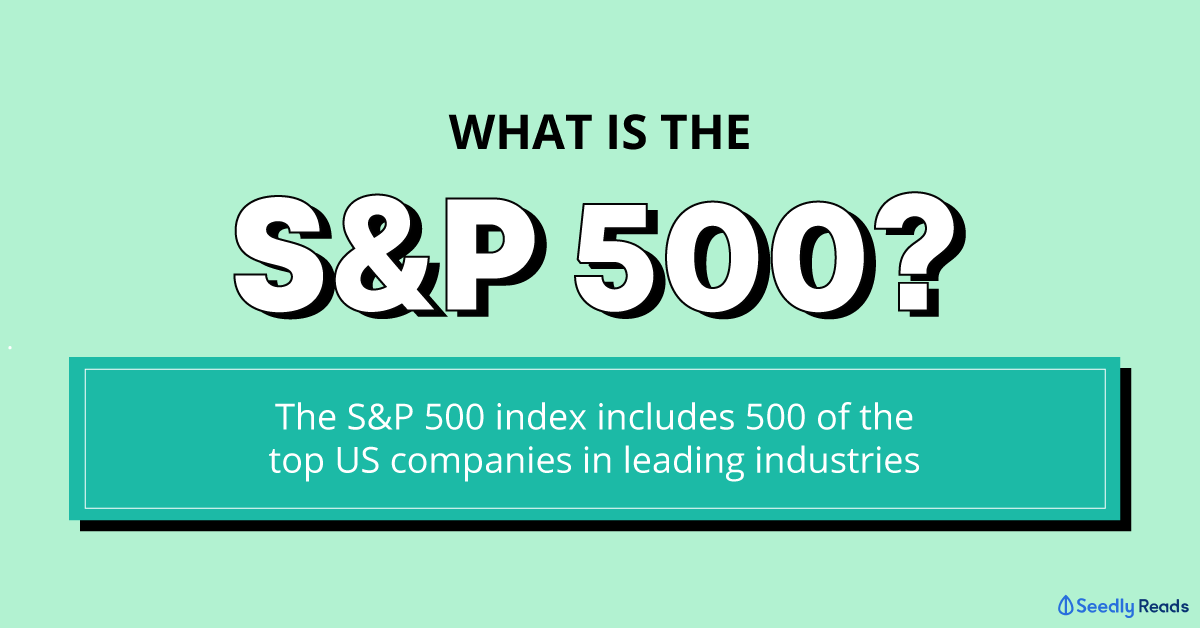Advertisement
Anonymous
What is the S&P 500 Index? There are so many S&P 500 ETFs out there listed in the US and Ireland. What are their differences? Which one should I invest in?
What are the things that I should take note of when investing in the S&P 500 ETFs?
15
Discussion (15)
Learn how to style your text
Reply
Save
Lim Qin Da
31 Jul 2020
Finance & Business Analytics at National University of Singapore
Hey Anon!
S&P 500 INDEX
The Standard & Poor’s 500 (S&P 500) Index includes 500 of the top US companies in leading industries. The index is weighted by market capitalisation, which refers to a company’s total number of outstanding shares multiplied by its share price. The S&P 500 index, which was created in 1957, is considered to be an excellent proxy to the US stock market performance.
Sounds too technical? Don’t zao first, read on…
If you’re looking at the S&P 500 index now, you would have probably heard of the Straits Times Index (STI). One way to see it is that the S&P 500 is the US counterpart to the STI.

Source: Yahoo Finance
The S&P 500 (dark blue) has been a hot topic in the community, mainly due to its exposure to the whole US market, as well as its performance over the last few years which greatly surpassed the STI (light blue). Some may even argue that an S&P 500 ETF could be all you need, or at least one of the major ETFs that you should hold on to for the long term.
So what exactly does it entail? Let’s find out…
To be added to the S&P 500 index, a company must meet the following criteria:
It must be a US company
The market capitalisation must be US$8.2 billion or higher
It must have a public float (shares that are in the hands of the public, as opposed to management, for example) of at least 50% of its outstanding shares
It must have positive as-reported earnings in its most recent quarter, and over the most recent four quarters summed up
The stock must have adequate liquidity and must trade for a reasonable share price
Constituents
As of 29 July 2020, the top 10 constituents of the S&P 500 index are:

Sector Classification
Based on the GICS sector classification, information technology (27.5%) takes up most of the S&P 500, followed by healthcare (14.6%), and consumer discretionary (10.8%).

Performance
Over the past 10 years, the S&P 500 index has produced an annualized return of 11.27%.

As of 29 July 2020, the index had a one-year return of 6.36%.
EXPENSES
There are several ETFs available in the market that seek to replicate the S&P 500’s returns. However, do note the expenses that will reduce your returns.
Withholding Tax

Singaporeans investing in the American market are taxed 30% on our dividends as the U.S does not have a tax treaty with Singapore. One way to go around this is to invest Ireland-Domiciled ETFs. These ETFs benefit from the U.S./Ireland tax treaty rate of 15% on dividends, which is certainly more pocket-friendly than 30%.
Expense Ratio
Expense ratio is the expense incurred to pay the managers for managing the fund. Choosing an actively managed fund will naturally cost more per year and eat into your returns. So as an investor, you want to find an ETF with a low expense ratio.
In the case of S&P 500 ETFs, Ireland-domiciled S&P 500 ETFs tend to have higher expense ratios than their US-listed counterparts. However, even with higher expense ratios, they are still cheaper than the higher withholding taxes you’d have to pay for investing in the American market directly!
So…
After seeing US and Ireland-domiciled ETFs being mentioned above, what exactly are they and what are their differences? Here are the popular ones which are constantly brought up by the community:
US-DOMICILED S&P 500 ETF
SPDR S&P 500 ETF (NYSE: SPY)
Inception Date: 22 January 1993
Expense Ratio: 0.09%
Distribution Frequency: Quarterly
iShares Core S&P 500 ETF (NYSE: IVV)
Inception Date: 15 May 2000
Expense Ratio: 0.03%
Distribution Frequency: Quarterly
Vanguard S&P 500 ETF (NYSE: VOO)
Inception Date: 7 September 2010
Expense Ratio: 0.03%
Distribution Frequency: Quarterly
IRELAND-DOMICILED S&P 500 ETF
SPDR S&P 500 UCITS ETF (LON: SPX5)
Inception Date: 19 March 2012
Expense Ratio: 0.09%
Distribution Frequency: Quarterly
iShares Core S&P 500 UCITS ETF (LON: CSPX)
Inception Date: 19 May 2010
Expense Ratio: 0.07%
Distribution Frequency: N/A (Accumulating, dividends reinvested)
Vanguard S&P 500 UCITS ETF (LON: VUSA)
Inception Date: 22 May 2012
Expense Ratio: 0.07%
Distribution Frequency: Quarterly
And on to your final question… Which one should you invest in?
US-domiciled S&P 500 ETFs seem to have lower expense ratios and narrow bid-ask spreads, but this is heavily offset by the whopping 30% withholding tax on dividends. They tend to have larger fund sizes and are traded more widely too.
On the other hand, the Ireland-domiciled S&P 500 ETFs have half the withholding tax on dividends at 15%, but liquidity is usually poorer than their US counterparts and they tend to have higher bid-ask spreads.
So after weighing the pros and cons…
If you have decided to invest in the US-domiciled S&P 500 ETFs, the ones with the lowest expense ratios are the iShares Core S&P 500 ETF (NYSE: IVV) and Vanguard S&P 500 ETF (NYSE: VOO), which are widely mentioned on the Seedly community. Do a simple search on the search bar above and you’ll be able to see the sea of questions being asked about IVV and VOO.
And if you have decided to invest in the Ireland-domiciled S&P 500 ETFs, the ones with the lowest expense ratios would be the iShares Core S&P 500 UCITS ETF (LON: CSPX) and Vanguard S&P 500 UCITS ETF (LON: VUSA). Do note that some of these ETFs have different ticker symbols and this is due to the currency that they are traded in (eg. GBP for VUSA and USD for VUSD). They tend to have slightly different performances too.
Still confused about the S&P 500? Here are some articles that Seedly has written which cover some areas in much greater detail:
Found out that the S&P 500 isn’t your cup of tea? Here’s the Ultimate Guide To Investing In Singapore which has a treasure trove of articles regarding the different investment options out there.
Happy investing!
References were made to the S&P 500 Fact Sheet. Click here to read more!
Disclaimer: The information provided serves as an educational piece and is not intended to be personalised investment advice. Readers should always do their own due diligence and consider their financial goals before investing.
Reply
Save
Write your thoughts
Related Articles
Related Posts
Related Products

Moomoo Singapore
4.7
485 Reviews
From $0
MINIMUM FEE
0.03%
TRADING FEES
Custodian
STOCK HOLDING TYPE

Saxo Markets
4.5
960 Reviews

CMC Invest
4.8
143 Reviews
Related Posts
Advertisement







CSPX is the best tax/fee-wise on longterm.